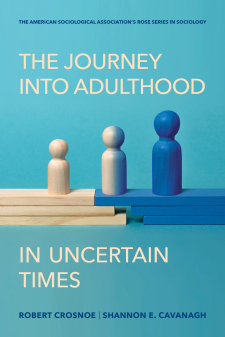Main navigation
 Today, roughly 70 percent of all visas for legal immigration are reserved for family members of permanent residents or American citizens. Family reunification—policies that seek to preserve family unity during or following migration—is a central pillar of current immigration law, but it has existed in some form in American statutes since at least the mid-nineteenth century. In her 2013 RSF book, Fictive Kinship: Family Reunification and the Meaning of Race and Nation in American Immigration, sociologist Catherine Lee delves into the fascinating history of family reunification to examine how and why our conceptions of family have shaped immigration, the meaning of race, and the way we see ourselves as a country.
Today, roughly 70 percent of all visas for legal immigration are reserved for family members of permanent residents or American citizens. Family reunification—policies that seek to preserve family unity during or following migration—is a central pillar of current immigration law, but it has existed in some form in American statutes since at least the mid-nineteenth century. In her 2013 RSF book, Fictive Kinship: Family Reunification and the Meaning of Race and Nation in American Immigration, sociologist Catherine Lee delves into the fascinating history of family reunification to examine how and why our conceptions of family have shaped immigration, the meaning of race, and the way we see ourselves as a country.
In a new interview with the Foundation, Lee discusses some of the groundbreaking research from her book and offers recommendations for future immigration policies. To learn more about Fictive Kinship or to purchase a copy, click here.
Q. As you point out in your book, family reunification has long been a guiding theme of U.S. immigration policy and has significantly influenced the changing demographics of the country. Can you give some examples of how family reunification policies have shaped the way we think about race and ethnicity in the U.S. today?
Family reunification—that is, provisions aimed at preserving or supporting family unity during or following migration—has been a constant in American immigration history, even before there were official policies in place. When family reunification was denied to earlier immigrant groups, the absence of permanent family settlement emboldened the view that they were inassimilable or un-American. Since passage of the Hart-Celler Act in 1965, which ended national origins policy and emphasized family reunification, family-sponsored immigration has become the central pathway to legal immigration to the United States, representing about two-thirds of total documented immigration. When family members of skilled immigrants and diversity lottery winners are included, family-sponsored immigration represents an even larger percentage of total legal immigration. Family reunification also has changed the racial and ethnic make-up of the United States by altering the demographic streams of entry. Although Europe was the dominant continental source of immigrants for much of U.S. history, the majority of family-sponsored immigrants today come from Asia and Latin America. In addition, for the first time since the United States began counting immigrants in 1819, immigrants from Africa outnumbered Europeans from 2008 to 2011. These changing immigration patterns are transforming our ideas about what a typical American is or about what minority and majority mean.
Q. In immigration debates, people don’t often focus in-depth on gender, but you argue that gendered labor shapes how we understand the relationship between family and nation. Can you elaborate on how women’s reproductive work has historically played a role in immigration policies?
Women’s reproductive work has played important physical and figurative roles in immigration policies and debates surrounding them. I discuss the historical significance of this in chapter three of the book. In the 19th century, traditional ideas about gender roles and marriage tied women’s nationality first, to her father and second, to her husband, denying them an independent nationality. Politicians, intellectuals, and moral reformers at the time both idealized and demonized women’s reproductive role in the family and the nation. They revered women’s work in producing proper citizen children if the women were white and middle class and castigated them for propagating too many children and overrunning the nation if they were racially undesirable. These sorts of claims helped politicians to pass exclusionary laws against Asians and Europeans from southern and eastern Europe. We see similar cries against Latina women today for birthing what exclusionists argue are “anchor babies.” Such rhetoric helps to fuel policies that shape, amongst other matters, access to healthcare provisions for poor immigrant women.
Q. You argue that family is fictively constructed, and that the definition of family has changed over time, with consequences for immigration policies. What are some historical examples that show how the meaning of family has shifted along with immigration policy?
When I argue that family is fictively constructed, I mean that there is no one “true” definition of family. Its meaning, like other concepts of relatedness such as race or nation, is socially constructed. How we define family has a tremendous effect on a broad range of social policy issues. For policy purposes, the U.S. government has defined family with some variability so that we have had at times more multi-generational ideas about family to more nuclear conceptions. There is a dynamic relationship between definitions of family and immigration policies affecting families. As I state above, traditional ideas about gender and marriage tied women’s opportunities to immigrate to their husbands. Since the Hart-Celler Act, the United States has provided a separate preference status for brothers and sisters of U.S. citizens. Many Asian and Latino immigrants and their advocates have argued that their definition of family is broader than a nuclear one and therefore includes siblings and parents. More recently, heteronormative ideals about marriage and family prohibited gays and lesbians in same-sex relationships from sponsoring their partners for immigration. The Supreme Court’s decision in 2013 to strike down the 1996 Defense of Marriage Act, which blocked federal recognition of same-sex marriage, was a legal coda to the shifting political and social views about gay marriage over the last two decades. For immigration purposes, family now includes same-sex marriages, and gays and lesbians may sponsor their same-sex spouses.
Q. The U.S. has just concluded a year marked by record deportations and a Congress deadlock on immigration reform. How is the notion of family guiding current immigration debates?
The notion of family plays an important emotional role in current immigration debates, like it has in previous ones. Regardless of the policy supported or legislated, no politician has ever opposed supporting families. Of course, the details are important. How will we address the needs of families seeking to reunite and face challenges in other areas of the current policy, including ensuring continued migration of skilled workers, fulfilling needs for regular flows of agricultural workers, and bringing the estimated 11.7 million unauthorized immigrants living in the United States out of the shadows?
The bipartisan bill passed by the Senate on June 27, 2013 proposes to change the current immigration policy emphasizing family reunification to one that balances merit-based immigration and family reunification. Currently, 480,000 visas (about 70 percent) a year are reserved for family reunification and 140,000 (about 20 percent) for employment-based immigrants. The Senate bill would maintain the annual worldwide level of family-based immigrant visas at 480,000 a year and allocate between 120,000 and 250,000 visas for merit or skill-based point system. While the bill would expand the category of “immediate relatives” by including spouses and children of legal permanent residents, it would reduce the annual floor of family-based immigrant visas from 226,000 to 161,000 and eliminate the visa category for siblings of U.S. citizens, forcing many immigrants with family ties in the United States to apply through the merit-based system.
These are just the proposed policy changes. As it has in previous debates surrounding immigration reform, how politicians talk about family—what it means and what roles it ought to play in our changing nation—will undoubtedly shape the parameters of the debate and the policies that are ultimately forged. Stories about separated families are helping to frame the current immigration system as broken. For example, because of over-subscribed visas, there are legal permanent residents who have waited years to be reunited with their spouses and children. Thus, there is widespread support for altering the current family preference categories—to limit, for example, sponsorship to immediate family members identified as spouses and unmarried children under 21 of legal immigrants already in the United States, thereby altering the definition of family to a nuclear one by dropping current family sponsorship categories for siblings.
In addition, supporters for providing a pathway to legalization for unauthorized immigrants have stressed that these immigrants’ unauthorized status leave them and their families vulnerable, including the estimated 16.6 million persons who live in mixed-status families—households that include members who may be citizen, legal permanent resident, or unauthorized. More than 80 percent of the children in such families are U.S. born citizens—an estimated 4.5 million children in 2011. Offering a path to legal status for unauthorized immigrants would have a huge impact on a significantly larger number of individuals, including many who are legal residents and citizens.
Q. House Speaker John Boehner recently indicated that he might be willing to strike a deal with Democrats on immigration reform in 2014. What are some of the most meaningful changes the Obama administration could implement to benefit immigrant families?
First and foremost, President Obama could change the administration’s policy on detention and deportation. He can direct Immigration and Customs Enforcement to stop detaining and deporting noncriminals and minors, many of whom have been ensnared by administration-supported programs like Secure Communities, which conducts immigration checks on individuals arrested by state and local law enforcement agencies. The Obama administration has deported around 400,000 persons per year, more than any previous administration. These actions separate families and leave those left behind in the United States especially vulnerable. Between 2010 and 2012, 200,000 parents of U.S. citizen children were deported, and over 5,000 children are now in foster care. By 2016, more than 15,000 children are expected to join them. With his record pace of deportations, President Obama has been able to claim that he has been tough about security and border control. It provides political leverage against conservative lawmakers who want to see stricter border enforcement prior to expanding immigration or offering a pathway to citizenship for unauthorized immigrants. Obviously, the problem is that these deportations separate families, many of which include citizen spouses and/or children.
The administration can also ensure that immigrant families, particularly those with children, are receiving social benefits to which they are entitled. Research shows that many legal immigrant families and mixed-status families avoid accessing social welfare programs such as the Supplemental Nutrition Assistance Program out of fear that they will attract unwanted attention from immigration officials. In addition, as Americans sign up to participate in the health insurance exchange made possible by the Affordable Care Act, the administration can help to sign up individuals who qualify, including eligible children who are U.S. citizens but whose parents are unauthorized immigrants.





